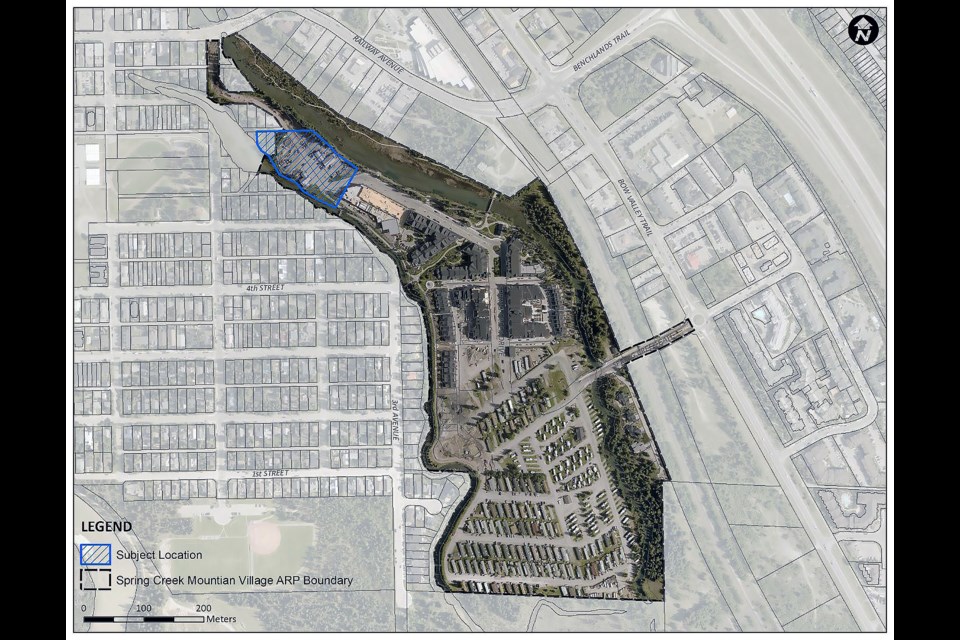CANMORE – A series of amendments will head to a public hearing as part of the Spring Creek Mountain Village area redevelopment plan.
Among the amendments are establishing land use in SCMV for stage 4 of development, updates to the direct control districts and changes to the development of future hotels and residential areas.
Canmore council gave first reading to the amendments, which will return for a public hearing on Aug. 16.
“There are a number of changes. It’s actually not a big change in the overall scope or the overall design, the overall impact. … I look forward to hearing from the public,” said Mayor Sean Krausert.
The amendments, if passed, would see part of the home park family residential district redesignated for public use such as parks and playgrounds and environmental protection of land.
It would also allow updates to maximum number of storeys, traffic monitoring requirement, maximum commercial area, location of tourist homes and location of employee housing.
Coun. Joanna McCallum noted the ARP was first approved in 2004 and expected to be completed in 10 years. However, outside factors such as the 2008 economic crisis and the COVID-19 pandemic brought significant delays outside the developer's control.
She praised SCMV for adapting to the change and evolving Town policies, but also using the time to introduce green technology such as solar and geothermal technology to reduce greenhouse gas emissions.
“We have seen that market forces and changes to the community have affected the length of time this ARP would be executed,” she said. “Therefore, it shows to me these changes would be natural.
“You need to naturally change with not only how our land use bylaw changes and expectations within the community, but also technology. We’ve seen more green pieces being added to the Spring Creek Mountain Village development over time, which is great.”
An amendment by Coun. Wade Graham to push the public hearing to Sept. 27 instead of August due to potential summer vacations was defeated 6-1.
Graham said he was concerned with summer vacations possibly getting in the way for people to explore the amendments. However, members of council indicated residents have an extra two weeks to write in submissions or voice support or concerns because of council’s summer schedule that won’t see them meet again until Aug. 16.
Claire Ellick, the Town’s transportation engineer, said the daily traffic count at Main Street and Spring Creek Drive was about 1,250. The goal is to not exceed 3,000 vehicles driving through Spring Creek each day.
Frank Kernick, the owner of SCMV, said the work on the intersection on Bow Valley Trail saw more traffic proceed through Spring Creek, increasing the daily number for the past two to three years to what he estimated at times was about 2,000.
Ellick said they have the opportunity to have an additional check down the road for any potential changes that may impact traffic.
The possible increase in commercial units through the two hotels could impact the offsite levy, but the extent is not yet known.
Whitney Smithers, the Town’s general manager of infrastructure, said they’re looking at updates for the Town’s offsite levy bylaw but it was unknown if any potential changes to SCMV would be encompassed in it. However, it would be captured by future changes, but not necessarily the next one.
Some of the changes, such as parking, are to align with the Town’s updated policies, while employee housing would allow clarification for it to be in or outside of SCMV.
The proposal would see hotel units permitted to jump from 200 to 250 – which includes the already constructed 124 units in the Malcolm – to help the “financial viability” of the project, according to the report.
Since being passed in 2004, the SCMV report stated more units are needed and the original maximum was more of an estimate. The Town staff report didn’t raise objections, especially with them being on existing pedestrian connections and proximity to downtown.
When council passed the ARP in 2004, the original proposal was 550 hotel units and 150 tourist homes. However, an amendment saw the hotel count reduced to 200 and tourist homes increased to 300, according to the McElhanney report for SCMV.
The three-storey Alexander Hotel would be a health and wellness retreat with 54 to 66 guestrooms, with 47 parking stalls.
The three-storey Kernick Place Hotel would be a family hotel with 50 to 57 guestrooms and 41 parking spots. A connected walkway to the Malcolm is also proposed and needs a separate agreement between the Town and SCMV.
The lots are to the north of the Malcolm Hotel and have a mix of existing use of parking and one single-family home.
Kernick said the intent is to start construction on the hotels in the next 18 to 24 months, but they first need clarity with the amendments before proceeding with detailed designs. He said the goal is to have the hotels completed in the next three to five years.
The first and second stages of development began in 2009, while stage 3 was in 2019. The ARP has received previous amendments in 2009, 2010 and 2015.
The proposed development would work “in an orderly manner” – especially with stage 3 just beginning – that’s outlined in the ARP to avoid leapfrog development. The ARP outlines stage 4 can only begin when stages 1 and 2 are completed, with the exception of an existing residential parcel, two hotel parcels and two municipal reserve parcels.
The estimated residential unit count – including the five per cent affordable housing – is 970 but not to exceed 1,000.
If approved, the total gross ARP would go from 28.37 hectares (70.1 acres) to 28.48 hectares (70.37 acres), while increasing the environmental reserve, gross developable land, commercial and resident space.
The total commercial street front space of all four stages would be 3,275 square metres and a 500-square-metre daycare.




